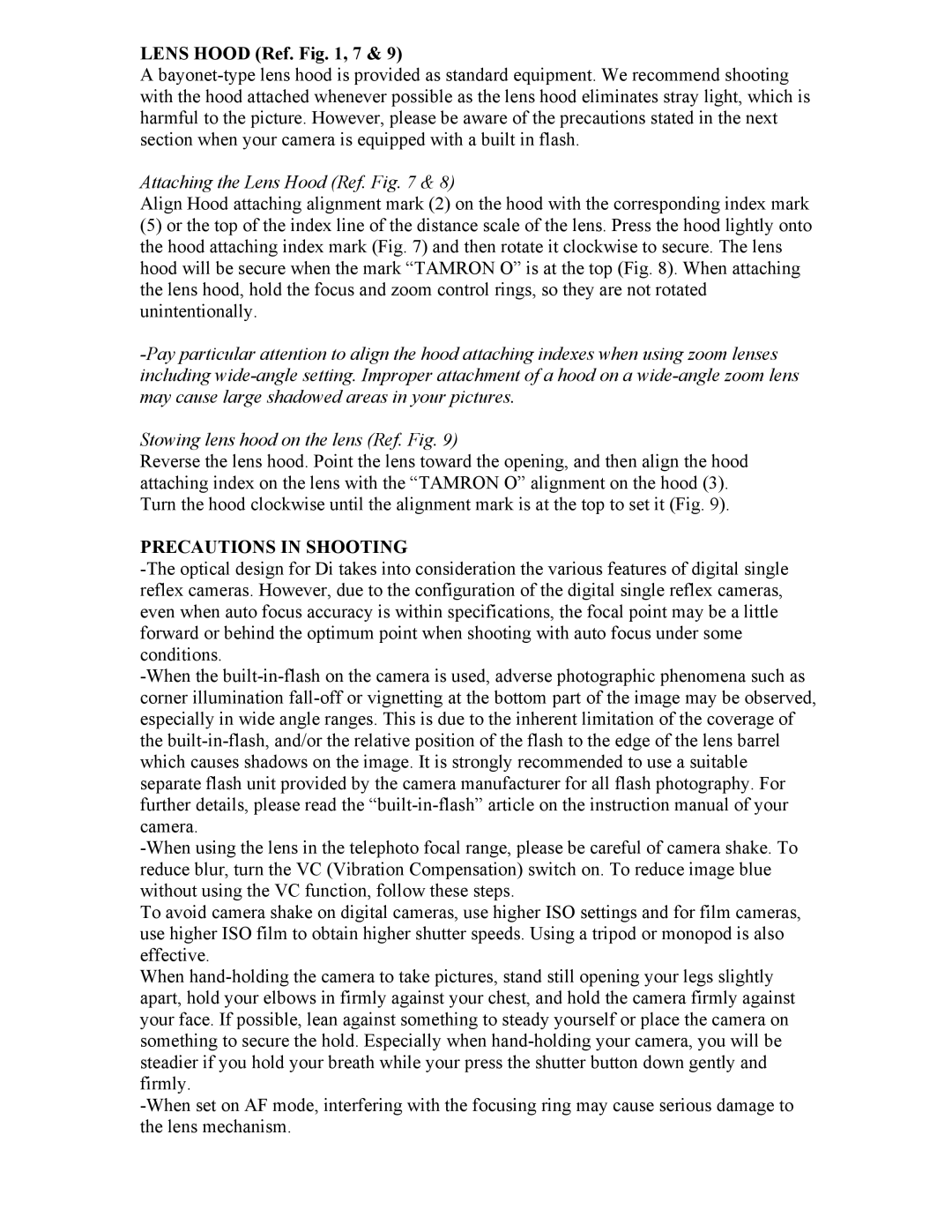LENS HOOD (Ref. Fig. 1, 7 & 9)
A bayonet-type lens hood is provided as standard equipment. We recommend shooting with the hood attached whenever possible as the lens hood eliminates stray light, which is harmful to the picture. However, please be aware of the precautions stated in the next section when your camera is equipped with a built in flash.
Attaching the Lens Hood (Ref. Fig. 7 & 8)
Align Hood attaching alignment mark (2) on the hood with the corresponding index mark
(5)or the top of the index line of the distance scale of the lens. Press the hood lightly onto the hood attaching index mark (Fig. 7) and then rotate it clockwise to secure. The lens hood will be secure when the mark “TAMRON O” is at the top (Fig. 8). When attaching the lens hood, hold the focus and zoom control rings, so they are not rotated unintentionally.
-Pay particular attention to align the hood attaching indexes when using zoom lenses including wide-angle setting. Improper attachment of a hood on a wide-angle zoom lens may cause large shadowed areas in your pictures.
Stowing lens hood on the lens (Ref. Fig. 9)
Reverse the lens hood. Point the lens toward the opening, and then align the hood attaching index on the lens with the “TAMRON O” alignment on the hood (3). Turn the hood clockwise until the alignment mark is at the top to set it (Fig. 9).
PRECAUTIONS IN SHOOTING
-The optical design for Di takes into consideration the various features of digital single reflex cameras. However, due to the configuration of the digital single reflex cameras, even when auto focus accuracy is within specifications, the focal point may be a little forward or behind the optimum point when shooting with auto focus under some conditions.
-When the built-in-flash on the camera is used, adverse photographic phenomena such as corner illumination fall-off or vignetting at the bottom part of the image may be observed, especially in wide angle ranges. This is due to the inherent limitation of the coverage of the built-in-flash, and/or the relative position of the flash to the edge of the lens barrel which causes shadows on the image. It is strongly recommended to use a suitable separate flash unit provided by the camera manufacturer for all flash photography. For further details, please read the “built-in-flash” article on the instruction manual of your camera.
-When using the lens in the telephoto focal range, please be careful of camera shake. To reduce blur, turn the VC (Vibration Compensation) switch on. To reduce image blue without using the VC function, follow these steps.
To avoid camera shake on digital cameras, use higher ISO settings and for film cameras, use higher ISO film to obtain higher shutter speeds. Using a tripod or monopod is also effective.
When hand-holding the camera to take pictures, stand still opening your legs slightly apart, hold your elbows in firmly against your chest, and hold the camera firmly against your face. If possible, lean against something to steady yourself or place the camera on something to secure the hold. Especially when hand-holding your camera, you will be steadier if you hold your breath while your press the shutter button down gently and firmly.
-When set on AF mode, interfering with the focusing ring may cause serious damage to the lens mechanism.
